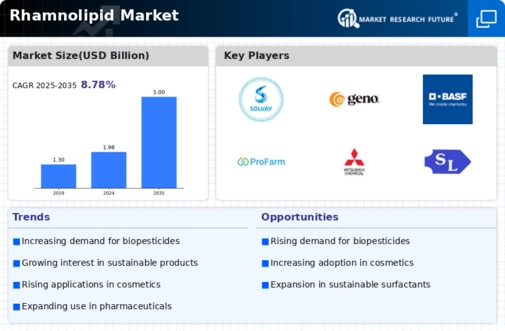Market Growth Projections
The Global Rhamnolipid Market Industry is projected to experience substantial growth, with estimates indicating a market value of 1.98 USD Billion in 2024 and a potential increase to 5 USD Billion by 2035. This growth trajectory suggests a compound annual growth rate of 8.79% from 2025 to 2035. Such projections reflect the increasing adoption of rhamnolipids across various sectors, driven by their eco-friendly properties and versatility. As industries continue to seek sustainable alternatives to traditional surfactants, the demand for rhamnolipids is likely to rise, reinforcing their position in the market. The anticipated growth underscores the importance of rhamnolipids in addressing environmental challenges.
Supportive Regulatory Frameworks
The Global Rhamnolipid Market Industry benefits from supportive regulatory frameworks that promote the use of natural and biodegradable products. Governments worldwide are implementing regulations that encourage the adoption of sustainable practices, particularly in industries such as agriculture and personal care. These regulations often favor the use of biobased surfactants like rhamnolipids, as they align with environmental goals and public health initiatives. The increasing number of certifications and eco-labels for products containing rhamnolipids further enhances their market appeal. As regulatory support continues to grow, it is likely to stimulate demand and foster a favorable environment for the expansion of the rhamnolipid market.
Technological Advancements in Production
Technological advancements in the production of rhamnolipids are poised to enhance the Global Rhamnolipid Market Industry significantly. Innovations in fermentation technology and metabolic engineering enable more efficient and cost-effective production processes. These advancements allow for higher yields and reduced production costs, making rhamnolipids more accessible to various industries. Furthermore, the development of genetically modified microorganisms can optimize the biosynthesis of rhamnolipids, leading to improved product quality. As production methods evolve, the market is expected to witness increased adoption of rhamnolipids, further contributing to the projected growth rate of 8.79% CAGR from 2025 to 2035.
Rising Demand for Biodegradable Surfactants
The Global Rhamnolipid Market Industry experiences a notable surge in demand for biodegradable surfactants, driven by increasing environmental awareness and regulatory pressures. Industries such as personal care, agriculture, and food processing are shifting towards sustainable alternatives to synthetic chemicals. Rhamnolipids, derived from microbial sources, offer eco-friendly properties that appeal to consumers and manufacturers alike. This shift is reflected in the projected market value of 1.98 USD Billion in 2024, with expectations to reach 5 USD Billion by 2035. The compound annual growth rate of 8.79% from 2025 to 2035 indicates a robust growth trajectory, underscoring the industry's potential in addressing sustainability concerns.
Expanding Applications in Various Industries
The versatility of rhamnolipids contributes significantly to the Global Rhamnolipid Market Industry, as they find applications across diverse sectors. In agriculture, rhamnolipids are utilized as biopesticides and soil conditioners, enhancing crop yield while minimizing chemical usage. In the personal care sector, they serve as natural emulsifiers and skin-conditioning agents. The food industry employs rhamnolipids for their antimicrobial properties, enhancing food safety. This broad applicability not only drives market growth but also fosters innovation in product development, as companies explore new formulations and uses. The increasing recognition of rhamnolipids' multifunctionality is likely to propel the market forward.
Growing Consumer Preference for Natural Products
The Global Rhamnolipid Market Industry is significantly influenced by the growing consumer preference for natural products. As consumers become more health-conscious and environmentally aware, there is a marked shift towards products that are free from synthetic chemicals. Rhamnolipids, being derived from natural sources, align with this trend and are increasingly favored in personal care and household products. This consumer shift is driving manufacturers to reformulate their products to include rhamnolipids, thereby enhancing market growth. The increasing demand for clean-label products is expected to further propel the market, as consumers seek transparency and sustainability in their purchasing decisions.





















Leave a Comment